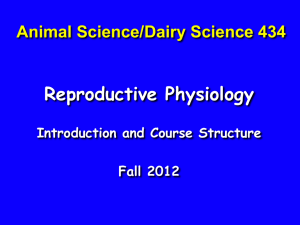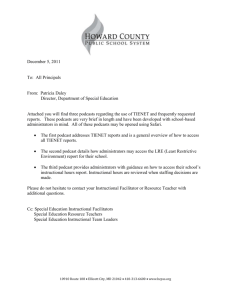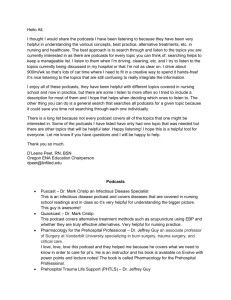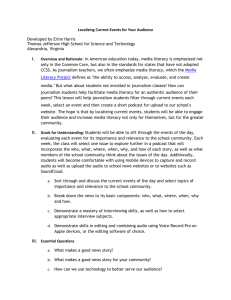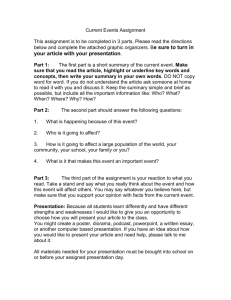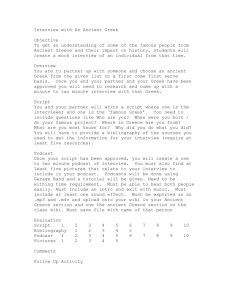SAMPLE READING COMPREHENSION LESSON
advertisement
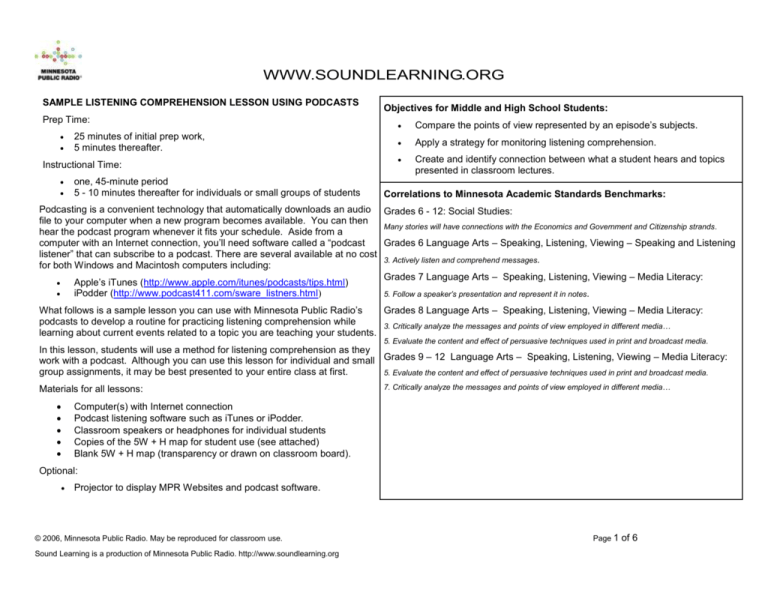
WWW.SOUNDLEARNING.ORG SAMPLE LISTENING COMPREHENSION LESSON USING PODCASTS Prep Time: 25 minutes of initial prep work, 5 minutes thereafter. Instructional Time: one, 45-minute period 5 - 10 minutes thereafter for individuals or small groups of students Podcasting is a convenient technology that automatically downloads an audio file to your computer when a new program becomes available. You can then hear the podcast program whenever it fits your schedule. Aside from a computer with an Internet connection, you’ll need software called a “podcast listener” that can subscribe to a podcast. There are several available at no cost for both Windows and Macintosh computers including: Apple’s iTunes (http://www.apple.com/itunes/podcasts/tips.html) iPodder (http://www.podcast411.com/sware_listners.html) Objectives for Middle and High School Students: Compare the points of view represented by an episode’s subjects. Apply a strategy for monitoring listening comprehension. Create and identify connection between what a student hears and topics presented in classroom lectures. Correlations to Minnesota Academic Standards Benchmarks: Grades 6 - 12: Social Studies: Many stories will have connections with the Economics and Government and Citizenship strands. Grades 6 Language Arts – Speaking, Listening, Viewing – Speaking and Listening 3. Actively listen and comprehend messages. Grades 7 Language Arts – Speaking, Listening, Viewing – Media Literacy: 5. Follow a speaker’s presentation and represent it in notes . What follows is a sample lesson you can use with Minnesota Public Radio’s Grades 8 Language Arts – Speaking, Listening, Viewing – Media Literacy: podcasts to develop a routine for practicing listening comprehension while 3. Critically analyze the messages and points of view employed in different media… learning about current events related to a topic you are teaching your students. 5. Evaluate the content and effect of persuasive techniques used in print and broadcast media. In this lesson, students will use a method for listening comprehension as they work with a podcast. Although you can use this lesson for individual and small Grades 9 – 12 Language Arts – Speaking, Listening, Viewing – Media Literacy: group assignments, it may be best presented to your entire class at first. 5. Evaluate the content and effect of persuasive techniques used in print and broadcast media. Materials for all lessons: 7. Critically analyze the messages and points of view employed in different media… Computer(s) with Internet connection Podcast listening software such as iTunes or iPodder. Classroom speakers or headphones for individual students Copies of the 5W + H map for student use (see attached) Blank 5W + H map (transparency or drawn on classroom board). Optional: Projector to display MPR Websites and podcast software. © 2006, Minnesota Public Radio. May be reproduced for classroom use. Sound Learning is a production of Minnesota Public Radio. http://www.soundlearning.org Page 1 of 6 WWW.SOUNDLEARNING.ORG © 2006, Minnesota Public Radio. May be reproduced for classroom use. Sound Learning is a production of Minnesota Public Radio. http://www.soundlearning.org Page 2 of 6 WWW.SOUNDLEARNING.ORG ABOUT PODCASTS MPR’s produces a variety of podcasts for its news and cultural programming; both short, under-10 minute reporting and commentary as well as full-length news programs. Once you subscribe to a podcast, new episodes are automatically downloaded and stored on your computer. If you intend to use the podcasts in a lab, you should spend a few minutes deciding how you’ll direct your students to subscribe to the podcasts you plan to use in your instruction. Before you plan to use podcasts with your class, you should check whether the machines students will use are configured to handle podcasts. Your computer must have a “podcast listener”, like Apple’s iTunes, installed as well as speakers or headphones. There are several podcast listeners available at no cost. Apple’s iTunes (http://www.apple.com/itunes/podcasts/tips.html) is well supported, free, and available for both the Macintosh and Windows computers. Other options include Juice and iPodder (see http://www.podcast411.com/sware_listners.html). Alternatively, you and your students may access and listen to recent episodes of a MPR podcast within their browser. For instance, recent Policast episodes can be heard at http://minnesota.publicradio.org/radio/podcasts/policast/. INITIAL PREP: Trying Out Podcasts Estimated time: 20 - 30 minutes Once your computers are ready to work with a podcast, follow this procedure: 1) Go to MPR’s Podcast page, http://minnesota.publicradio.org/radio/podcasts/. Identify which podcast might be applicable to the topics you want your students to read. 2) Follow the instructions for copying the podcast’s link into your podcast software. 3) In your podcast, select “Add Subscription” and paste the URL you copied. Your podcast listener will start to download the latest episodes automatically. 4) Click on an episode of interest. Think of how you’ll demonstrate using the podcasting software. You may need to remind your students that they will be switching between a browser and the podcasting software as they use the MPR website and podcasts. 5) Determine how you’ll use the podcast subscription with your class. Once you’ve taught your students a routine for accessing the podcast and a method for quickly analyzing an episode, you may use the feature all year long for individual, small group, or whole class instruction. The sample lesson below outlines one possible use for podcasts in your classroom. Whole Class Introductory Lesson PREP Estimated time: 10 - 15 minutes 1) Go to MPR’s podcast page, http://minnesota.publicradio.org/radio/podcasts/ . Find a podcast applicable to the topic you’re teaching. 2) Preview the episode to identify possible key vocabulary words your students might need help understanding. 3) If you are using the 5W + H Map, type or write the vocabulary words into the 5W + H Map. Print it off and make enough copies for each of your students. © 2006, Minnesota Public Radio. May be reproduced for classroom use. Sound Learning is a production of Minnesota Public Radio. http://www.soundlearning.org Page 3 of 6 WWW.SOUNDLEARNING.ORG 4) Walk through the episode once more, this time filling out the 5W + H Map to help you determine how to model each section: subject and subject’s point of view (who), the story’s key events (what), the story’s location (where), when the story occurred (when), the circumstances that created the events (why), and how the story relates to the topic you’re teaching (how). 5) Determine the student pairs and arrange your classroom accordingly. INSTRUCTION Estimated time: 20 - 50 minutes, depending on episode length. 1) Explain to your students that during your course they’ll use MPR podcasts to keep current on a topic you’re teaching. They’ll also learn a method for analyzing a story that will help them monitor and compare what they’ve read during your course. 2) Prior to playing the episode, review any vocabulary or key terms you flagged. 3) Introduce the “5W + H” method and distribute the optional map as you explain the method. Explain that as students read through the story, they should note the story’s subjects and each subject’s point of view (this may have to be inferred), what happened, as well as when, where, and why it happened. Finally, they should note how the story is related to what they’re studying in your course. 4) Play audio segment and direct students to write down the 5W’s+ H: Who, What, When, Where, Why and How. 5) After the segment plays, give the students a moment to finish their observations. Then discuss the segment’s topic and add student input to the 5W + H map on the board. 6) If some students are having trouble identifying what to include in their 5W + H map, display the map you filled out during the prep stage. Replay the passage and have students pause the audio when they hear information you recorded in the map. 7) After an appropriate amount of time, review with your class the story’s topic. Add student input to the 5W + H map you created as a transparency or on your board. 8) Have students reflect independently or discuss with their partners whether they agree or disagree with any of the points of views or solutions presented. Encourage students to think how the issues covered in the story might apply to what they’re studying in your course. For students having trouble making connections, encourage them to refer to the notes added to the 5W+H Map in step 6. 9) Discuss with your students what they think the final outcome of the story will be and how that will impact those affected by the story’s event or issue. What future stories might occur because of what transpired in this story? 10) If time allows, have your class evaluate the story for objectivity and accuracy of information. Ask for any specific examples of bias, being sure to make the distinction between a source’s opinion and a reporter’s bias. 11) Close by explaining that they’ll be using the same method throughout your course for independent or small group study of topics related to the subject you’re studying. They’ll use this method each time they work with a MPR podcast. INDEPENDENT AND/OR SMALL GROUP WORK: © 2006, Minnesota Public Radio. May be reproduced for classroom use. Sound Learning is a production of Minnesota Public Radio. http://www.soundlearning.org Page 4 of 6 WWW.SOUNDLEARNING.ORG Once your students have become proficient with using the 5W + H method to analyze podcast episodes, you may choose to assign this lesson for students to follow on their own, perhaps once a week while you take attendance and perform other logistics. Alternatively, you might assign students to use the 5W + H method to analyze a certain number of articles during your course. EXTENSIONS & ADAPTATIONS: 1) About 5 minutes: If your students are over the age of 13, have personal reactions or connections to the story, and your district’s AUP allows filling out and submitting online forms, consider having your students post their reactions to the MPR News Forum – (http://news.forum.publicradio.org/) 2) About 20 – 30 minutes: Assign students, individually or in pairs, to write a summary for the story using only one of the presented points of view. 3) About 5 – 10 minutes: Encourage your students to contribute to the reporting. Click on the link “Help us cover this story” in the “Respond to this story” sidebar, if available. © 2006, Minnesota Public Radio. May be reproduced for classroom use. Sound Learning is a production of Minnesota Public Radio. http://www.soundlearning.org Page 5 of 6 WWW.SOUNDLEARNING.ORG Name: _____________________ Date: __________ Time: ________ 5W + H Map Who: Point of View: Who: Who: Point of View: Who: Point of View: Point of View: Summary: What: _______________________________________________ Why: _______________________________________________ _______________________________________________ _______________________________________________ _______________________________________________ When: How: _______________________________________________ _______________________________________________ Where: Key words to know: © 2006, Minnesota Public Radio. May be reproduced for classroom use. Sound Learning is a production of Minnesota Public Radio. http://www.soundlearning.org Page 6 of 6
